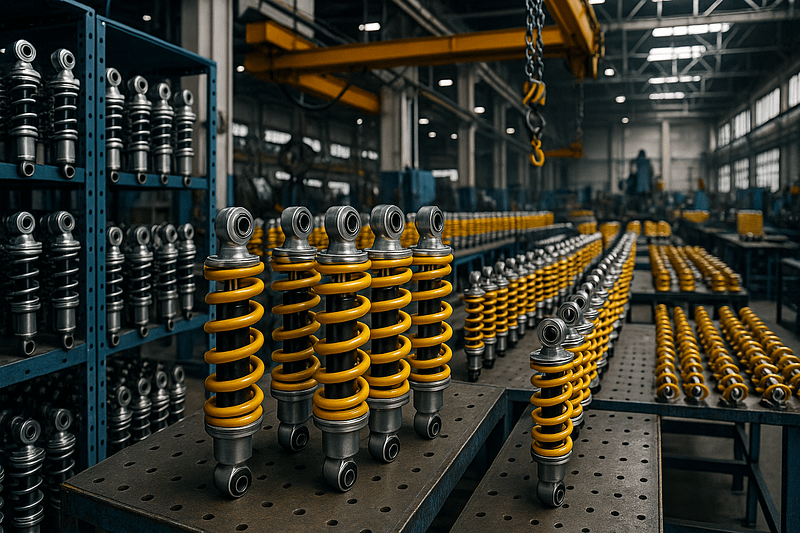As someone deeply immersed in automotive suspension technologies, I often encounter questions about the differences between monotube and twin-tube shock absorbers. Understanding these distinctions is pivotal for enhancing vehicle performance, comfort, and safety. In this guide, I’ll provide an in-depth comparison to help you make an informed decision.
Shock Absorber Basics
Shock absorbers are integral components of a vehicle’s suspension system, designed to control unwanted spring motion and improve ride quality. Both monotube and twin-tube shocks serve the fundamental purpose of dampening vibrations but utilize different architectures.
Key Components
- Piston and cylinder assembly: Controls fluid movement
- Damping medium: Hydraulic fluid
- Valving systems: Manage compression and rebound
Monotube Shock Absorbers
Design and Construction
Monotube shocks are characterized by a single cylindrical housing containing both the piston and hydraulic fluid. They are:
- Built in one tube with a floating piston that separates the oil from pressurized gas
- High-pressure systems (up to 360 PSI)
Performance Characteristics
Monotube shock absorbers are known for:
- Enhanced heat dissipation: Single-tube design allows superior cooling
- Consistent performance: Maintains damping quality across varied conditions
- Precise handling: Offers excellent responsiveness, crucial for performance driving
Advantages
- Better performance: Ideal for high-speed and off-road applications
- Durability: Pressurized design minimizes aeration and cavitation
- Superior stability: Provides enhanced control during rapid maneuvers
Limitations
- Higher cost: Generally more expensive than twin-tube systems
- Firm ride: May not provide the comfort preferred by casual drivers
Twin-Tube Shock Absorbers
Design and Construction
Twin-tube shocks feature an inner cylinder and an outer reservoir. They are:
- Dual-chamber systems with a base valve controlling fluid flow
- Typically low-pressure systems
Performance Characteristics
Twin-tube shock absorbers are popular for:
- Smooth operation: Known for softer ride comfort at moderate speeds
- Cost-effectiveness: Generally economical compared to monotube systems
- Volumetric efficiency: Better fluid capacity and management within the same physical space
Advantages
- Comfortable ride: Offers smoothness preferred for everyday driving
- Affordability: Lower initial investment for most standard applications
- Simplified design: Less complex construction facilitates routine maintenance
Limitations
- Heat accumulation: More susceptible to performance fade due to poorer heat dissipation
- Cavitation risk: Fluid aeration can affect damping consistency
Comparative Performance Analysis
Driving Scenarios
Performance and Racing:
- Monotube: Superior handling and heat management make it ideal
- Twin-Tube: Less responsive under high-performance conditions
Daily Commuting:
- Monotube: Can provide a firm but controlled ride
- Twin-Tube: Offers comfort and smoothness for casual driving
Terrain Considerations
Off-Road Driving:
- Monotube: Preferred for its robustness and stability
- Twin-Tube: Tend to wear out faster under intense conditions
Urban Roadways:
- Monotube: May be too firm for average urban roads
- Twin-Tube: Provides adequate comfort and damping
Cost and Maintenance
Initial Investment
Monotube:
- Generally costs more due to advanced design and materials
Twin-Tube:
- More budget-friendly with easier installation options
Long-Term Maintenance
Monotube:
- Requires less frequent maintenance due to consistent performance
Twin-Tube:
- May necessitate regular inspection due to potential aeration issues
Making the Right Choice for Your Vehicle
Assessment Criteria
Usage Patterns:
- Consider your driving habits, road conditions, and vehicle type
Budget Considerations:
- Factor in initial costs and long-term maintenance expenses
Performance Needs:
- Evaluate whether enhanced performance or comfort is your priority
Vehicle-Specific Recommendations
Sedans and Light Vehicles:
- Twin-Tube for cost-effectiveness and comfort
SUVs and Trucks:
- Monotube for durability in heavy-duty and off-road applications
Sports and Racing Cars:
- Monotube to maximize performance and responsiveness
Conclusion
Whether you choose monotube or twin-tube shock absorbers, understanding their design principles and performance characteristics is vital for optimizing your vehicle’s suspension system. Monotube shocks deliver superior handling and durability, suitable for demanding applications, while twin-tube shocks offer a cost-effective solution for smooth and comfortable everyday driving.
In the end, selecting the right type of shock absorber should reflect your specific driving needs, vehicle usage, and budget constraints. By prioritizing quality and having professional installations, you can ensure consistent performance and driving satisfaction.



